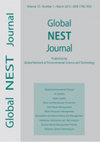太阳能光催化处理二次处理废水中雌激素和病原体的同时去除
IF 1.2
4区 环境科学与生态学
Q4 ENVIRONMENTAL SCIENCES
引用次数: 10
摘要
最近,环境相关样品中新兴化合物的命运引起了相当大的关注。太阳能半导体光催化可以提供一种有吸引力的方法来处理这类污染物。同时,利用太阳能光催化对水和废水进行消毒是文献中记载的一个话题。为此,以模拟太阳辐射和TiO2为光催化剂,研究了合成雌激素17α-乙炔雌醇(EE2)的同时降解和大肠杆菌的去除。一般来说,水基质越复杂,大肠杆菌的去除速度越慢,而反应混合物中大肠杆菌的存在并没有阻碍EE2的去除。虽然EE2的去除相对较快,但总体雌激素活性仅部分去除。这意味着,在流出物和/或一些光催化转化副产物中固有存在的其他物种可能按比例比EE2更具雌激素性。总的来说,利用太阳辐射可以构成一种有利的处理策略,可以同时从二级处理的流出物中去除微污染物和病原体。本文章由计算机程序翻译,如有差异,请以英文原文为准。
Simultaneous removal of estrogens and pathogens from secondary treated wastewater by solar photocatalytic treatment
Recently, the fate of emerging compounds in environmentally relevant samples has attracted considerable attention. Solar semiconductor photocatalysis may offer an appealing methodology to treat such contaminants. At the same time the use of solar photocatalysis for water and wastewater disinfection is a topic well-documented in the literature. In this respect, the simultaneous degradation of synthetic estrogen 17α-ethynylestradiol (EE2) and Escherichia coli removal employing simulated solar radiation and TiO2 as the photocatalyst was investigated. In general, the more complex the water matrix is the slower E. coli removal becomes, while the presence of E. coli in the reaction mixture did not obstruct EE2 removal. Although EE2 removal occurred relatively fast, overall estrogenic activity was only partially removed. This implies that other species inherently present in the effluent and/or some photocatalytic transformation by-products may be proportionately more estrogenic than EE2. Overall, the use of solar radiation can constitute an advantageous treatment strategy for the simultaneous removal of micropollutants and pathogens from secondary treated effluent.
求助全文
通过发布文献求助,成功后即可免费获取论文全文。
去求助
来源期刊

Global Nest Journal
环境科学-环境科学
CiteScore
1.50
自引率
9.10%
发文量
100
审稿时长
>12 weeks
期刊介绍:
Global Network of Environmental Science and Technology Journal (Global NEST Journal) is a scientific source of information for professionals in a wide range of environmental disciplines. The Journal is published both in print and online.
Global NEST Journal constitutes an international effort of scientists, technologists, engineers and other interested groups involved in all scientific and technological aspects of the environment, as well, as in application techniques aiming at the development of sustainable solutions. Its main target is to support and assist the dissemination of information regarding the most contemporary methods for improving quality of life through the development and application of technologies and policies friendly to the environment
 求助内容:
求助内容: 应助结果提醒方式:
应助结果提醒方式:


